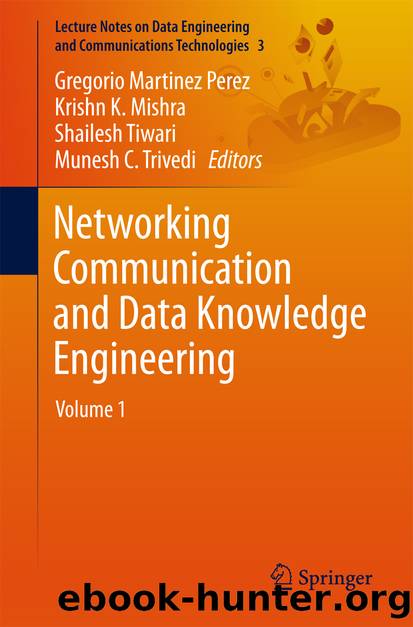Networking Communication and Data Knowledge Engineering by Gregorio Martinez Perez Krishn K. Mishra Shailesh Tiwari & Munesh C. Trivedi

Author:Gregorio Martinez Perez, Krishn K. Mishra, Shailesh Tiwari & Munesh C. Trivedi
Language: eng
Format: epub
Publisher: Springer Singapore, Singapore
3 Proposed Scheduler for VANET Based Safety Application
In this section a LTE scheduler is proposed that can be used for VANET based safety applications. LTE being an infrastructure based network, all safety messages need to pass through the road side unit (RSU). A typical safety message is small in size and is transmitted in a periodic fashion. As the vehicle density increases in a given road segment such safety messages can create congestion especially in case of a LTE network as all are routed to the RSU or base unit [21, 22]. This congestion results in delay at the receiving of such messages to communicating vehicles. Safety applications in case of VANETs are sensitive to delay and vary from vehicle to vehicle, road segment to road segment [23, 24]. This is so because high speed vehicles travel a greater distance in a small amount of time in comparison to slow speed vehicles. This makes certain road segments more sensitive in comparison to others such as intersections this is so because the vehicles direct line of sight is not clear. Thus such regions require greater accuracy.
Schedulers which are unaware of the channel are not suitable for safety applications to be used in VANETs this so because resource allocation is done by them without considering channel quality, fading etc. Schedulers that are aware of the channel are also not suitable for safety applications in VANET as they provide maximum throughput but do not consider delay in messages which is not accepted in delay-critical safety applications. Therefore there is requirement of a scheduler which could be implemented in safety applications for VANETs that takes into account vehicle information and then allocates resources among communicating vehicles [25, 26]. The proposed scheduler uses a control channel which carries only critical information of a communicating vehicle to another vehicle. The communicating vehicle can also send channel quality; buffer status and other information using this control channel however capacity of this channel is very low. Separate parameters are defined for capturing and sending vehicle speed and location. The scheduler makes use of the core LTE server for gathering information of vehicle speed and location. In case of a situation where the proposed scheduler (PS) is unable to receive information from the server or the information received is out-dated then in such a case the PS makes use of a pre-defined value for vehicle speed. Then speed can be estimated for a given vehicle ‘k’ as:
Download
This site does not store any files on its server. We only index and link to content provided by other sites. Please contact the content providers to delete copyright contents if any and email us, we'll remove relevant links or contents immediately.
Algorithms of the Intelligent Web by Haralambos Marmanis;Dmitry Babenko(8518)
Test-Driven Development with Java by Alan Mellor(7348)
Data Augmentation with Python by Duc Haba(7250)
Principles of Data Fabric by Sonia Mezzetta(6994)
Learn Blender Simulations the Right Way by Stephen Pearson(6929)
Microservices with Spring Boot 3 and Spring Cloud by Magnus Larsson(6761)
RPA Solution Architect's Handbook by Sachin Sahgal(6166)
Hadoop in Practice by Alex Holmes(6028)
Jquery UI in Action : Master the concepts Of Jquery UI: A Step By Step Approach by ANMOL GOYAL(5869)
The Infinite Retina by Robert Scoble Irena Cronin(5868)
Big Data Analysis with Python by Ivan Marin(5692)
Life 3.0: Being Human in the Age of Artificial Intelligence by Tegmark Max(5398)
Pretrain Vision and Large Language Models in Python by Emily Webber(4652)
Infrastructure as Code for Beginners by Russ McKendrick(4436)
WordPress Plugin Development Cookbook by Yannick Lefebvre(4166)
Functional Programming in JavaScript by Mantyla Dan(4121)
The Age of Surveillance Capitalism by Shoshana Zuboff(4111)
Embracing Microservices Design by Ovais Mehboob Ahmed Khan Nabil Siddiqui and Timothy Oleson(3956)
Applied Machine Learning for Healthcare and Life Sciences Using AWS by Ujjwal Ratan(3929)
